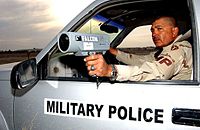Doppler radar

Hey there, kiddo! Have you ever seen a police car with flashing lights and heard a siren wailing past you? Well, imagine if that police car was checking the speed of cars on the road using a special tool called a radar gun.
Now, imagine a much bigger radar gun, but instead of pointing at cars, it's pointing at the sky. That's what Doppler radar does! It's a tool that helps scientists and meteorologists study weather patterns and track things like hurricanes, thunderstorms, and tornadoes.
How does it work? Doppler radar sends out a beam of energy, like a flashlight, towards the air around it. The energy bounces off things like raindrops, snowflakes, and even bugs in the air. When the beam of energy hits one of these things, some of it bounces back and gets picked up by the radar machine.
The Doppler radar machine can then tell a few things about the thing it bounced off of, like its location, how big it is, and how fast it's moving. It can even tell if the thing is moving towards the radar or away from it, because when the thing is moving towards the radar, the energy that bounces back to it is sort of squished together, like when someone shouts at you from across the room.
And when the thing is moving away from the radar, the energy is sort of stretched out, like when someone is singing while they walk away from you. This "squishing" or "stretching" of the energy is called the Doppler effect, which is why it's called "Doppler" radar.
So, scientists and meteorologists use Doppler radar to help them understand and predict weather patterns. They can see how fast a storm is moving and in what direction, which helps them warn people who might be in the storm's path to get to safety. Cool, huh?
Now, imagine a much bigger radar gun, but instead of pointing at cars, it's pointing at the sky. That's what Doppler radar does! It's a tool that helps scientists and meteorologists study weather patterns and track things like hurricanes, thunderstorms, and tornadoes.
How does it work? Doppler radar sends out a beam of energy, like a flashlight, towards the air around it. The energy bounces off things like raindrops, snowflakes, and even bugs in the air. When the beam of energy hits one of these things, some of it bounces back and gets picked up by the radar machine.
The Doppler radar machine can then tell a few things about the thing it bounced off of, like its location, how big it is, and how fast it's moving. It can even tell if the thing is moving towards the radar or away from it, because when the thing is moving towards the radar, the energy that bounces back to it is sort of squished together, like when someone shouts at you from across the room.
And when the thing is moving away from the radar, the energy is sort of stretched out, like when someone is singing while they walk away from you. This "squishing" or "stretching" of the energy is called the Doppler effect, which is why it's called "Doppler" radar.
So, scientists and meteorologists use Doppler radar to help them understand and predict weather patterns. They can see how fast a storm is moving and in what direction, which helps them warn people who might be in the storm's path to get to safety. Cool, huh?
Related topics others have asked about:
